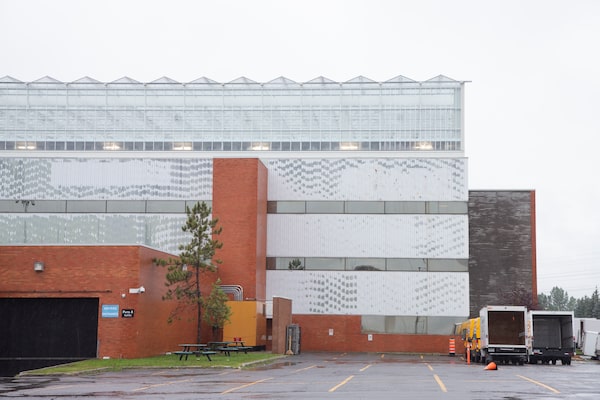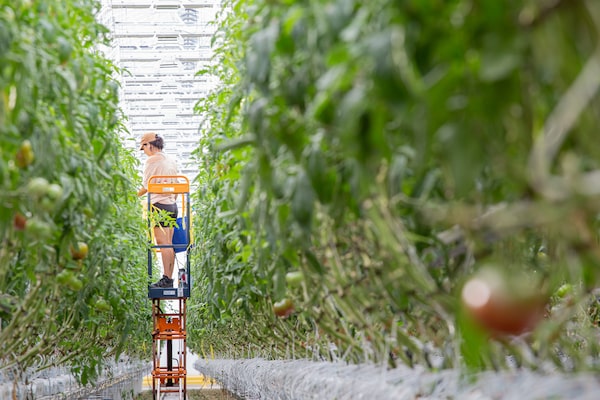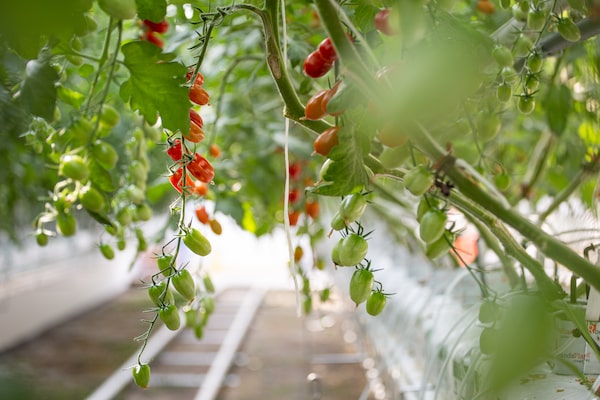
The Lufa greenhouse sits atop a former Sears warehouse in Montreal's St-Laurent neighbourhood.christinne muschi/The Globe and Mail
In the industrial part of Montreal’s St-Laurent area, it can be hard to distinguish the bulky buildings from one another, except for one – the roof sticks out like a green thumb.
It’s a great glass greenhouse roof atop a former Sears warehouse – a giant vegetable garden, said by its creators to be the world’s biggest commercial rooftop greenhouse.
The 163,000-square-foot garden, which opened last week, is the equivalent of nearly three football fields worth of food. To date, it is the fourth and biggest commercial facility for Montreal-based Lufa Farms.
Lufa is already well known among local “Lufavores” – foodies, restaurants and alterna-living people in the Montreal area, who value its fresh tomatoes, eggplants and vegetables, as well as the produce it gathers from local farmers.
Growing food on roofs represents the future of farming, especially in these pandemic times, says Mohamed Hage, Lufa’s chief executive officer, who co-founded the company with his wife, Lauren Rathmell.
“When we looked at how to grow where people live, we realized that there was only one option – rooftops. It’s not sustainable to always be trucking food in from across the continent or shipping from all over the world,” Mr. Hage says.
The new building was planned and construction began well before COVID-19 hit the world, but it offers a strong response to the pandemic, he explains.
“In March, 2020, we saw a doubling of demand for our food. Growing food locally on rooftops and sourcing from local farming families allows us to swiftly adjust and respond to this demand,” he says.

An employee works inside the Lufa greenhouse.Handout
Co-founder Ms. Rathmell, who is also Lufa’s greenhouse director, says it took three months to build the St-Laurent facility and grow the site.
“That would normally have taken years,” she says.
“In response to COVID-19, we enacted stringent safety protocols early on, launched seven-day service, tripled our home-delivery capacity and launched new software tools,” she says. The company also brought in more than 200 new team members, 35 new local farmers and food makers and 30,000 new Lufavores customers.
Lufa’s new staff includes two full-time nurses to take workers’ temperatures as well as “social-distancing police” to walk around and make sure workers aren’t too close to one another, Mr. Hage says. The company has also boosted the frequency of its air exchange in all of its facilities, including the new one.
Designing and building a rooftop greenhouse is challenging, Mr. Hage says. Although some of the preparation required is not much different than getting any equipment onto a roof, some of the prep work up there is more complicated, he says.
“We have to meet national building codes, and of course everything for the greenhouse needs to be hauled up to the roof on a crane,” he says. “Yet once it’s there, you have to do a lot of stuff manually rather than mechanically. All of this is harder than it would be to do on the ground.”
It’s also expensive. “This greenhouse costs two times as much as a ground-based greenhouse,” he says. Lufa declines to give out the cost of this latest project but says the first of its four facilities, built 10 years ago, cost $2.2-million.
Using buildings for farming is catching on, says Mike Zelkind, co-founder of 80 Acres Farms in Cincinnati, Ohio, which also operates building-based facilities in Arkansas, North Carolina and New York.
“A field can be the least efficient place to grow food,” he says. “An indoor farm can produce more than 300 times more food, with 100-per-cent renewable energy and 97 per cent less water. That’s the beauty of growing in buildings.”

Montreal-area foodies value Lufa's fresh tomatoes, eggplants and various other vegetables.Handout
Similarly, in Poughkeepsie, N.Y., up the Hudson River from New York City, restaurateur, food-truck owner and chef John Lekic pivoted as the COVID-19 lockdowns spread to launch an indoor farming business called Farmers & Chefs.
“We use technology from an Israeli company called Vertical Field that was being showcased at the Culinary Institute of America, which is nearby,” he says. The Israeli company supplies all the materials to grow some 200 different crops on roofs and in parking lots with minimal experience required.
“We planted and installed a container in March and our first harvest was in April,” Mr. Lekic says. “We’re learning fast, but it’s an easy way to grow herbs and produce.”
Mr. Hage agrees, adding that “rooftops are superior places for an urban farm.”
“When we started [in 2009], we considered leasing parking lots for growing, but no one wanted to give them up,” he recalls. “But for most commercial building owners, rooftops are unloved – they leak, they have to be maintained and, in a cold climate like ours, you have to clean off the snow. A commercial rooftop greenhouse is a solution.”
The new St-Laurent project gives Lufa a total of about 300,000 square feet of agricultural production, and the company plans to eventually expand into Southern Ontario and the U.S. northeast.
Mr. Hage points out that a rooftop greenhouse also makes great sense in terms of environmental sustainability and reducing energy and carbon emissions.
“We don’t use pesticides and our greenhouses use half the energy that a greenhouse at ground level would consume because we use heating from the building that rises up to the roof,” he explains.
“The biggest challenge is not the greenhouse space – who doesn’t want to walk around in a warm sunny greenhouse when it’s 20 below outside? The challenge is maximizing the warehouse space below the greenhouse,” he says. “We’re growing so many tomatoes that the warehouses never seem to be big enough to store them.”
Urban farming in Canada is still a niche in a nationwide food industry that is primarily export-based, and accounts for 12 per cent, or $62.5-billion, of Canada’s total exports every year, says Claire Citeau, executive director of the Canadian Agri-Food Trade Alliance (CAFTA).
But in a post-COVID-19 world, every bit of food production counts, she says. “We continue to see the adoption of science, technology and innovative ways to feed people and create new economic opportunities at home and abroad.”
And if that’s not enough, just look at the place, Mr. Hage says. “Boy, do I like driving by – it sticks out like a crystal,” he says. “And when you go inside, it’s like being in a spa.”